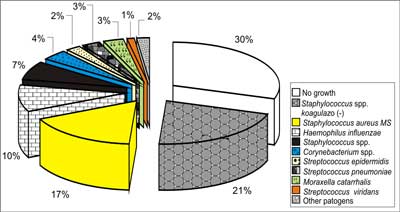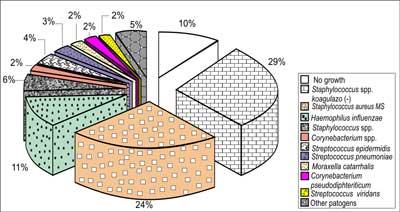© Borgis - New Medicine 3/2008, s. 57-59
*Magdalena Frąckiewicz, Lechosław P. Chmielik, Mieczysław Chmielik
BACTERIAL AETIOLOGY OF CHRONIC RHINOSINUSITIS IN CHILDREN
Department of Paediatric Otorhinolaryngology, Medical University of Warsaw, Poland
Head of Department: Prof. Mieczysław Chmielik, MD, PhD
Summary
Introduction: Chronic rhinosinusitis (CRS) is an inflammatory process affecting the mucosa of the nasal cavities and paranasal sinuses. The inflammation lasts more than 12 weeks. In the aetiology of rhinosinusitis bacteria dominate. The most common are: Streptococcus pneumoniae, Haemophilus influenzae, Moraxella catarrhalis.
Aim: To assess bacteriological testing of samples taken from the middle nasal turbinates and lumen of maxillary sinuses of children operated on for chronic rhinosinusitis.
Material and method: The research included 116 children treated surgically in the Department of Paediatric Otolaryngology, Medical University of Warsaw. The material for bacteriological examination was taken during the surgical procedure from both the middle nasal turbinates and maxillary sinuses
Results: Two diagrams presented below show the most frequent pathogens causing chronic rhinosinusitis. Both in the material from the maxillary sinuses and from the middle nasal turbinates Staphylococcus spp. coagularo (-) was cultured most frequently.
Conclusions: 1. Results of bacteriological testing in the examined group differ from the most common aetiology that causes chronic rhinosinusitis. 2. Results taken from the middle nasal turbinate differ from the results taken from the lumen of the maxillary sinuses.
INTRODUCTION
The definition of chronic rhinosinusitis (CRS) describes a group of diseases of various aetiology, caused by a chronic inflammatory process affecting the mucosa of the nasal cavities and paranasal sinuses that lasts constantly over 12 weeks, which cannot be cured by pharmacological treatment (1, 3, 5).
According to Meltzer the symptoms of CRS can be divided into two groups, as major and minor symptoms (4, 5):
Major symptoms include:
– muco-purulent discharge present in the anterior rhinoscopy and/or in the posterior nostrils and posterior wall of the pharynx,
– impaired patency of the nose,
– dull headaches.
And minor symptoms include:
– headaches of different character,
– bursting otalgia,
– cough,
– sub-febrile body temperature,
– fatigue,
– fetor ex ore,
– toothaches.
In the aetiology of rhinosinusitis bacteria dominate. Most frequently CRS is caused by Streptococcus pneumoniae, Haemophilus influenzae, Moraxella catarrhalis.In some cases mycotic and anaerobic aetiology should be considered (1, 2, 3).
AIM
To assess bacteriological testing of samples taken from the middle nasal turbinates and lumen of the maxillary sinuses of children operated on for chronic rhinosinusitis.
MATERIAL AND METHOD
116 patients were collected into a group of children with chronic rhinosinusitis (51 females, 65 males) aged 5 to 17 treated surgically in the Department of Paediatric Otolaryngology, Medical University of Warsaw. In the analyzed group 2 cases of mucoviscidosis were noted. In all cases endoscopic sinus surgery was performed. The material for bacteriological examination was taken during the surgical procedure from both the middle nasal turbinates and maxillary sinuses. Inoculation of bacteria was cultured into a medium produced by Biomerieux.
RESULTS
The most common pathogens were: Staphylococcus spp. coagulazo(-), Staphylococcus aureus MS, Haemop- hilus influenzae, Staphylococcus spp., Corynebacterium spp., Streptococcus pneumoniae, Streptococcus epidermidis and Moraxella catarrhalis. In the group "other pathogens” Bacillus spp., P. aeruginosa, Pantoea spp., Acinetobacter lwoffii, Escherichia coli, Actinomyces naeslundii, Gemella morbillorum and Alcaligenes were included. Results are presented in the diagrams below.
DISCUSSION
In the literature bacteria are described as being the most frequent pathogens causing rhinosinusitis. Fungi, anaerobic bacteria and viruses are a rare aetiology. In our research the material was taken during the surgical procedure from both the middle nasal turbinates and lumen of the maxillary sinuses 8, 9, 10. The three most common bacteria that were cultured were: Staphylococcus spp. coagulazo(-), Staphylococcus aureus MS, Haemophilus influenzae.This difference is probably caused by the use of antibiotics in the aggravation of the chronic process. The most common antibiotics prescribed in Poland are amoxicillin, cefuroxime and clindamycin. Recently we can observe overuse of antibiotics especially in the practice of family doctors 6, 7.
In our research in some cases we discovered a lack of correlation between the results of inoculation from the middle turbinates and maxillary sinuses.

Fig. 1. Bacteriological testing from maxillary sinuses.

Fig. 2. Bacteriological testing from maxillary sinuses.
CONCLUSIONS
1. Results of bacteriological testing in the examined group differ from the most common aetiology that causes chronic rhinosinusitis.
2. Results taken from middle nasal turbinate differ from the results taken from the lumen of the maxillary sinuses.
Piśmiennictwo
1. Otolaryngologia Dziecięca pod red. D Gryczyńskiej, 2007. 2. Małafiej E.: Antybiotykoterapia zapaleń zatok. Prz. Alergol. 2006: 2 (5); 24-30. 3. Otoryno-laryngologia praktyczna pod red. G Janczewskiego, 2005. 4. Meltzer and col. Rhinosinusitis: establishing definitions for clinical research and patient care Journal of Allergy And Clinical Immunology, 2004 Dec. 114 (6). 5. Bluestone Ch, Stool S, et al.: Pediatric Otolaryngology. Saunders, Philadelphia, 1993. 6. Dzierżanowska-Fangrat K, Dzierżanowska D.: Zakażenia w otolaryngologii - etiopatogeneza i terapia. Stand. Med. 2006: 3 (1),12-16. 7. Hryniewicz W.: Zakażenie układu oddechowego: etiologia, epidemiologia i diagnostyka mikrobiologiczna. Ter. Leki 2003: 53 (2), 5-15. 8. Sandler NA, Johns FR, Braun TW.: Advances in the management of acute and chronic sinusitis. J Oral Maxillofac Surg 54: 1005-1013, 1996. 9. Vaidya M, Chow JM, Stankiewicz JA, et al.: Correlation of Middle Meatal and Maxillary Sinus Cultures in Acute Maxillary Sinusitis. American Journal of Rhinology, Vol. 11, Nr 2, March-April 1997 , pp. 139-143 (5). 10. Axelsson AMD, Brorson JEMD.: The correlation between bacteriological findings in the nose and maxillary sinus in acute maxillary sinusitis. Laryngoscope. 83 (12): 2003-2011, December 1973.

